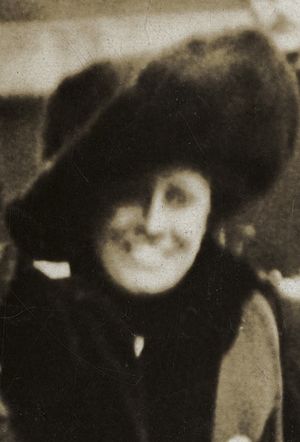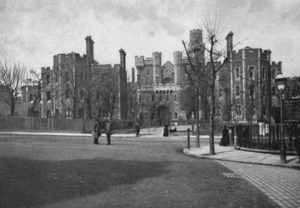Emma Sproson facts for kids
Quick facts for kids
Emma Sproson
|
|
|---|---|
 |
|
| Born |
Emily Lloyd
13 April 1867 West Bromwich, Staffordshire, England
|
| Died | 22 December 1936 (aged 69) Tettenhall, Staffordshire England
|
| Nationality | English |
Emma Sproson (born Emily Lloyd, 13 April 1867 – 22 December 1936) was a brave English woman. She fought for women's rights and was a suffragette. This means she was part of the movement that wanted women to have the right to vote. Emma was also a socialist and a politician. She came from a working-class family in the Midlands. She made history by becoming the first female councillor in Wolverhampton. People often called her "Red Emma" because of her strong beliefs.
Contents
Emma Sproson's Early Life
Emma Sproson was born Emily Lloyd on 13 April 1867. Her birthplace was West Bromwich, which is now in the West Midlands. She was one of seven children. Her parents, Ann and John, were very poor. Her father built canal boats. In the mid-1870s, her family moved to Wolverhampton. Around this time, young Emma started working part-time. She ran errands and collected coal from local waste piles.
When she was about nine years old, Emma left home. She began working as a house helper. Even though she worked, she still went to school four days a week. At age thirteen, she got a job in a shop. However, she was fired. Without a job, she moved to Lancashire to find work. There, she taught at a Sunday school and joined a church debating group.
How Emma Sproson Became an Activist
A historian named Jane Martin says that a public political meeting changed Emma's life. It was a key moment in her journey to support women's right to vote. At this meeting, Emma asked a question to Lord Curzon. He refused to answer her. He said it was because "she was a woman and did not have the vote." This made Emma even more determined.
Emma returned to Wolverhampton by 1895. She had saved enough money to start her own business. It was probably a shop in the front room of her house. Around this time, she joined the Independent Labour Party (ILP). In August 1896, she married Frank Sproson. He was a postman and also supported women's right to vote. They had four children, but only three lived: Chloris, Frank, and George.
Joining the Fight for Votes
In October 1906, Frank Sproson invited Emmeline Pankhurst to speak. Emmeline was a leader of the Women's Social and Political Union (WSPU). Emma was the chairperson for this meeting. Emmeline Pankhurst even stayed at the Sproson's home. Soon after, Emma joined the WSPU. She began writing many letters to local newspapers. She wanted to share her views on women's suffrage.
In early 1907, Emma went to suffrage meetings in London. On 13 February, she attended a WSPU meeting. After the meeting, she joined a march to parliament. The marchers tried to enter the Palace of Westminster. Police stopped them, and Emma was arrested. She could either pay a fine or go to prison for two weeks. She chose prison. The next month, she was arrested again during another march. This time, she was sent to Holloway Prison for a month. While there, Christabel Pankhurst, a WSPU co-founder, visited her.
After her release, Emma spoke at a special lunch. This event celebrated the release of all the imprisoned activists. She then returned to Wolverhampton. There, she and another WSPU member, Jennie Baines, spoke at a public meeting. Emma then went on a speaking tour for the WSPU. She visited many towns in the Black Country.
New Groups and Protests
By late 1907 or early 1908, Emma Sproson became unhappy with how the Pankhursts led the WSPU. She felt they were too strict. So, she left the WSPU and joined the Women's Freedom League (WFL). This group used non-violent methods to fight for suffrage. Emma became the WFL's branch secretary in Wolverhampton. By February 1908, she was also a member of their national leadership team.
Emma was also part of the Women's Tax Resistance League. This group refused to pay taxes. They did this to protest that women could not vote. Refusing to pay tax was also a policy of the WFL. In April 1910, Emma spoke at a large WFL gathering. It was held in Trafalgar Square with Amy Sanderson and Muriel Matters. In May 1911, she was sent to prison for seven days. This was because she refused to pay for a dog licence. While in prison, she went on a hunger strike. This meant she refused to eat. Because of this, she was recognized as a political prisoner. Sadly, her dog was shot by the police.
In November 1911, Emma Sproson joined a group to meet the Prime Minister, H. H. Asquith. This group included WFL leader Charlotte Despard and three other WFL members. By April 1912, Emma was again unhappy with the leadership. She felt Charlotte Despard was too controlling. So, Emma left the WFL. After this, she stopped working on national campaigns. Instead, she focused on local politics in her own area.
Emma Sproson's Local Politics
In 1919 and 1920, Emma Sproson ran for local elections. She was a candidate for the Labour Party in Wolverhampton. She did not win these first attempts. But in 1921, she ran in the Dunstall area and won! By doing so, she became Wolverhampton's first female councillor. To celebrate her win, she waved a red flag from the balcony of Wolverhampton town hall. This is how she got her famous nickname, "Red Emma."
As a councillor, she worked on important committees. She helped with health issues, especially mental health. She also worked on housing for single mothers. In late 1922, she raised concerns about money matters at a local hospital. An investigation followed, but her claims were not supported. She faced some challenges within her party because of this.
Emma Sproson successfully kept her council seat in the 1924 local election. However, she left the Labour Party before the next election in 1927. She ran as an independent candidate but lost. This marked the end of her active political life.
Emma Sproson's hearing became worse in her later years. She passed away at home on 22 December 1936. Historian Jane Martin says that Emma's work showed that the women's suffrage movement was not just for rich women in London. It also included brave working-class women from places like the Midlands.
|




